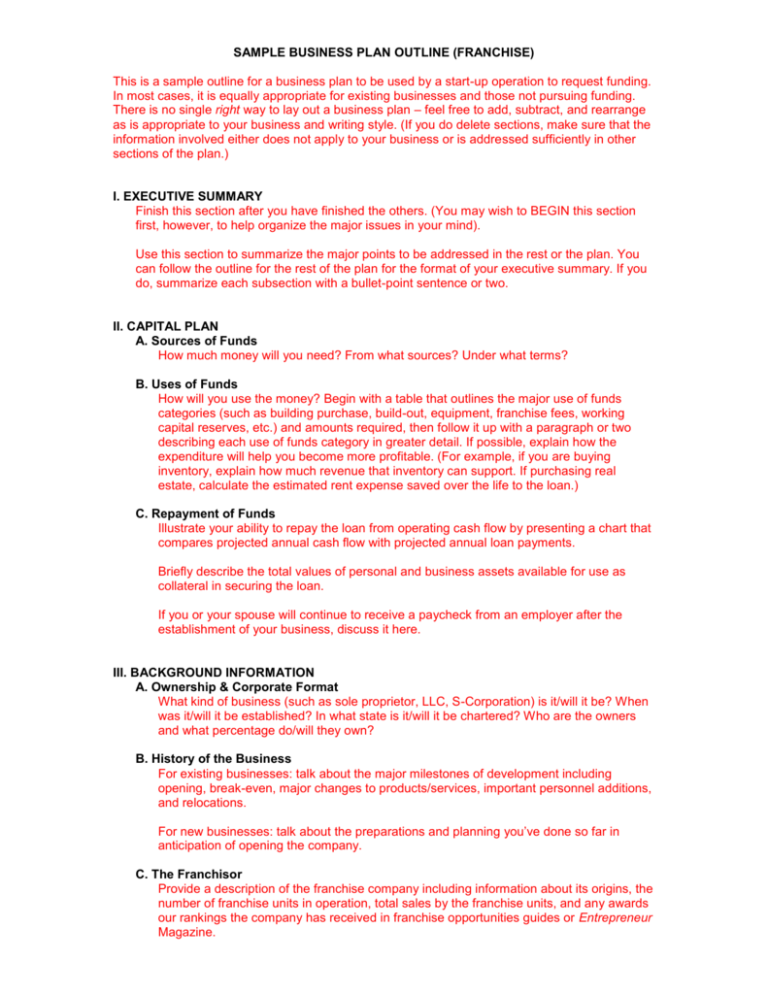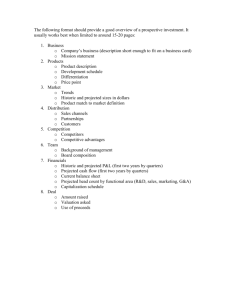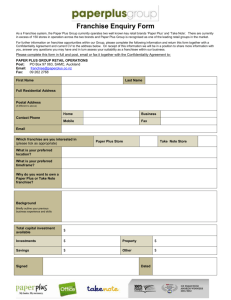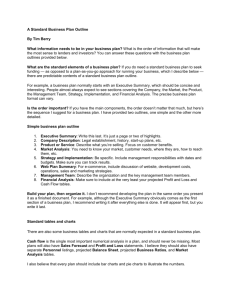sample business plan outline (start-up)
advertisement

SAMPLE BUSINESS PLAN OUTLINE (FRANCHISE) This is a sample outline for a business plan to be used by a start-up operation to request funding. In most cases, it is equally appropriate for existing businesses and those not pursuing funding. There is no single right way to lay out a business plan – feel free to add, subtract, and rearrange as is appropriate to your business and writing style. (If you do delete sections, make sure that the information involved either does not apply to your business or is addressed sufficiently in other sections of the plan.) I. EXECUTIVE SUMMARY Finish this section after you have finished the others. (You may wish to BEGIN this section first, however, to help organize the major issues in your mind). Use this section to summarize the major points to be addressed in the rest or the plan. You can follow the outline for the rest of the plan for the format of your executive summary. If you do, summarize each subsection with a bullet-point sentence or two. II. CAPITAL PLAN A. Sources of Funds How much money will you need? From what sources? Under what terms? B. Uses of Funds How will you use the money? Begin with a table that outlines the major use of funds categories (such as building purchase, build-out, equipment, franchise fees, working capital reserves, etc.) and amounts required, then follow it up with a paragraph or two describing each use of funds category in greater detail. If possible, explain how the expenditure will help you become more profitable. (For example, if you are buying inventory, explain how much revenue that inventory can support. If purchasing real estate, calculate the estimated rent expense saved over the life to the loan.) C. Repayment of Funds Illustrate your ability to repay the loan from operating cash flow by presenting a chart that compares projected annual cash flow with projected annual loan payments. Briefly describe the total values of personal and business assets available for use as collateral in securing the loan. If you or your spouse will continue to receive a paycheck from an employer after the establishment of your business, discuss it here. III. BACKGROUND INFORMATION A. Ownership & Corporate Format What kind of business (such as sole proprietor, LLC, S-Corporation) is it/will it be? When was it/will it be established? In what state is it/will it be chartered? Who are the owners and what percentage do/will they own? B. History of the Business For existing businesses: talk about the major milestones of development including opening, break-even, major changes to products/services, important personnel additions, and relocations. For new businesses: talk about the preparations and planning you’ve done so far in anticipation of opening the company. C. The Franchisor Provide a description of the franchise company including information about its origins, the number of franchise units in operation, total sales by the franchise units, and any awards our rankings the company has received in franchise opportunities guides or Entrepreneur Magazine. D. Industry Overview What is the size, growth, and overall trends of the industry? Resources: Trade Associations, FCPL BRC, Internet E. Benefits of the Franchise Approach Describe the basic benefits of the franchise approach and discuss the statistical comparisons between survival rates for franchise-affiliated businesses and independent businesses. F. Objectives Explain your quantitative (such as profit and sales targets) as well as qualitative (such as market position) goals for your company. If possible, briefly explain your overall strategies for reaching those goals. G. Implementation Timeline What are the major tasks and milestones to be reached as you move forward. For each, provide an estimate of how long it will take to accomplish. H. Future Opportunities Use this section to describe future opportunities you hope to pursue, but don’t yet know enough about the hows, whens, and ifs to include them in your financial projections. IV. THE FRANCHISOR-FRANCHISEE RELATIONSHIP A. Support Provided by the Franchisor Discuss the different types of support and benefits provided through your affiliation with the franchisors. These topics can include: market-proven products and operating format, well-known brand, volume purchase discounts, marketing support, management counseling, and training, among others. B. Responsibilities of the Franchisee Discuss the payment and performance requirements that you will be expected to meet, including franchise fees, royalties, and minimum sales goals. V. PRODUCTS AND SERVICES A. Overview Briefly provide a basic overview of the products and services your company will provide. B. Description of Products/Services by Category For each major product/service category, describe: the nature of the products/services in the category, pricing and pricing policies, direct costs involved. DO THE MATH: If you will provide a limited number of standard products/services, provide a chart projecting annual totals for projected unit sales within each category, average prices for each category, and projected sales based on projected units and pricing. VI. MANAGEMENT, STAFFING, STRATEGIC PARTNERS, AND PROFESSIONAL SUPPORT If feasible, provide a table that summarizes your projected staff and payroll for each of the first three years of operations. A. Management Team Provide profile for each owner who will participate in operations as well as each major manager. Discuss major job responsibilities as well as specific skills and experiences of each manager that qualifies them to handle the job at hand. Touch on career highlights here and include complete resumes in the attachments. Discuss compensation. B. Staffing If your staff will be modest, provide descriptions of each job title here. If you have particular people already selected for these positions, discuss their qualifications. If not, discuss the qualifications required for successful candidates. Discuss how staffing needs will change as the company grows. Discuss compensation. C. Strategic Partners Strategic partners are others who have a major effect on the way you do business, but are not part of your organization. These can include vendors, general contractors (if you are a subcontractor), subcontractors, landlords, collaborative marketing partners, and others. D. Professional Support Briefly list professionals you will use and describe how you will use them. These can include attorneys, accountants, bookkeepers, payroll services, consultants, insurance brokers, graphic designers, and others. A sentence or two for each is sufficient. VII. OPERATIONS A. Hours and Days of Operation How will your hours and days of operation be configured to meet the needs of your customers? B. Location & Facilities Location – where will the business be located? Is location important to the success of your operation? How will this location contribute to that success? What businesses and potential customers are nearby? For retail businesses, provide traffic counts if you can. Facilities – describe the actual location, including total square footage, allocation of space, parking (if appropriate). Discuss office & computer equipment, as well as other equipment and vehicles required. If renting, describe the lease. Describe how your facilities needs will change as the business grows. C. Licensing, Permitting & Other Regulatory Issues Describe the regulatory requirements for doing business, including any certifications, licenses, permits, registrations. Also discuss any zoning or building regulations. For home based businesses, discuss any homeowners’ association restrictions. Discuss your current status in regard to those requirements. Resources: BLIS, Planning & Zoning, Comptroller’s Office, Clerk of Circuit Court D. Other Operational Issues Address any other operational issues that have not been covered in other sections. Retitle this section and add others as appropriate. VIII. MARKETING A. Marketing Targets Provide as much detail as possible about your most likely customers. Who are they? What is important to them? Where are they? Do they have things in common that makes it possible to efficiently reach them with marketing messages? Also, don’t forget about past and current customers as a productive source of business. Referral sources should also be a marketing target. Resources: FCPL Business Resource Center (Best Customers, Reference USA), Trade Associations, Internet B. Distribution Discuss how your products and services will get into the hands of their users. Will you sell direct? With you sell through retailers? Wholesalers? Many companies use a combination of these approaches. Talk about the relative merits and challenges of each distribution model you will use. If you will use wholesalers and/or retailers and have identified specific candidates, discuss them and your expected relationship with them. C. Competitive Environment and Positioning Discuss your major direct competitors and your comparative strengths and weaknesses. Remember, very few businesses truly have “no competition” – even if no one in the marketplace provides exactly what you do, customers often have the option of simply not buying from anyone, buying alternative types product or service, or buying over the Internet. How will you position yourself against these options as well as your direct competitors? Resources: Trade Associations, Yellow Pages, FCPL BRC (Reference USA), Internet D. Marketing Tactics What tools will you use to promote your products and services? Create a section for each major marketing tactic (such as advertising, internet promotions, direct mail, trade shows, etc.) as well as subsections (such as print advertising, TV advertising, radio advertising, etc.), as applicable. Describe how and when you will use these tools and how your tactics will interact for cohesive, organized marketing campaigns. IX. FINANCIAL SUMMARY A. Sales Present a chart summarizing your annual projections for total sales in each of the next three years. If appropriate, make it a “stacked” chart providing a visual presentation of each sales category’s contribution to total annual sales. B. Profits Present a chart summarizing your annual projections for total sales, gross profits, and net profits in each of the next three years. C. Expenses Based on three-year projected totals and the equation [income = expenses + profits], provide a pie chart that presents the percentage of total income equaled by each major expense category (such as costs of sales, rent, payroll, minor expenses combined into a single “all other expenses” category), and profits. D. Break-Even Based on three-year projected annual averages and the equation [profits = variable cost % x sales – fixed costs], provide a chart illustrating projected profit at various potential sales levels. If your cost structure will change dramatically from year to year, you may need to provide a separate break-even analysis for each year. ATTACHMENTS - Projected Income Statement (Cash Basis) – 3 years, monthly Minimum requirements: 1 year monthly, plus 2 years quarterly. It’s easier just to do all three years on a monthly basis. Include a cash flow calculation section after profit calculations. - Projected Balance Sheet, 3 years - Resumes - Others, could include: Product Information, Letters of Interest/Sales Contracts, Reprints, Marketing Materials, Others








